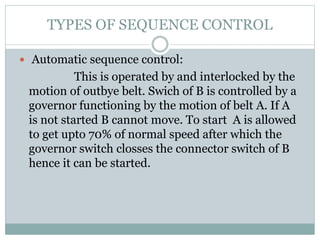Sequence control
- 1. www.MINEPORTAL.in ONLINE TEST SERIES FOR ï DGMS COAL/METAL FIRST/SECOND CLASS EXAM ï GATE MINING EXAM ï OVERMAN EXAM TEST ï MINING INSPECTOR EXAMS ï COAL INDIA MTs & OTHER PSUs EXAMS FREE STUDY MATERIAL & VIDEO LECTURES MINING JOBS NOTIFICATIONS www.mineportal.in Call/Whatsapp-8804777500 www.fb.com/mineportal.in
- 3. INTRODUCTION ï Stoping of the outbye belt may cause piling up of the inbye belt, leading to overload and the subsequent friction may cause fire. ï Sequence control in conveyor is to avoid any belt damage as result of the outbye belt being stalled.
- 4. PRINCIPLE 1. The inbye cannot be set in motion unless outbye is upto 60%-70% of normal speed. 2. If the outbye stops for a reason the inbye stops automatically.
- 5. TYPES OF SEQUENCE CONTROL ï Automatic sequence control: This is operated by and interlocked by the motion of outbye belt. Swich of B is controlled by a governor functioning by the motion of belt A. If A is not started B cannot move. To start A is allowed to get upto 70% of normal speed after which the governor switch closses the connector switch of B hence it can be started.
- 6. ï Pilot sequence control: There is pilot cable throughout the system and only pilot cable is control. The supply of inbye is controlled by auxilliary contacts on each contactor. The disadvantage is to use pilot cable throughout hence increasing the cost.
- 7. Remote control of conveyors: On conveyor system the remote control switch connnected at the delivery point can be connected in parallel to a cable running the length of the conveyor for press buttons inserted for local control. Pull wire is connected all along the circuit and a pull at the wire stops the conveyor.







